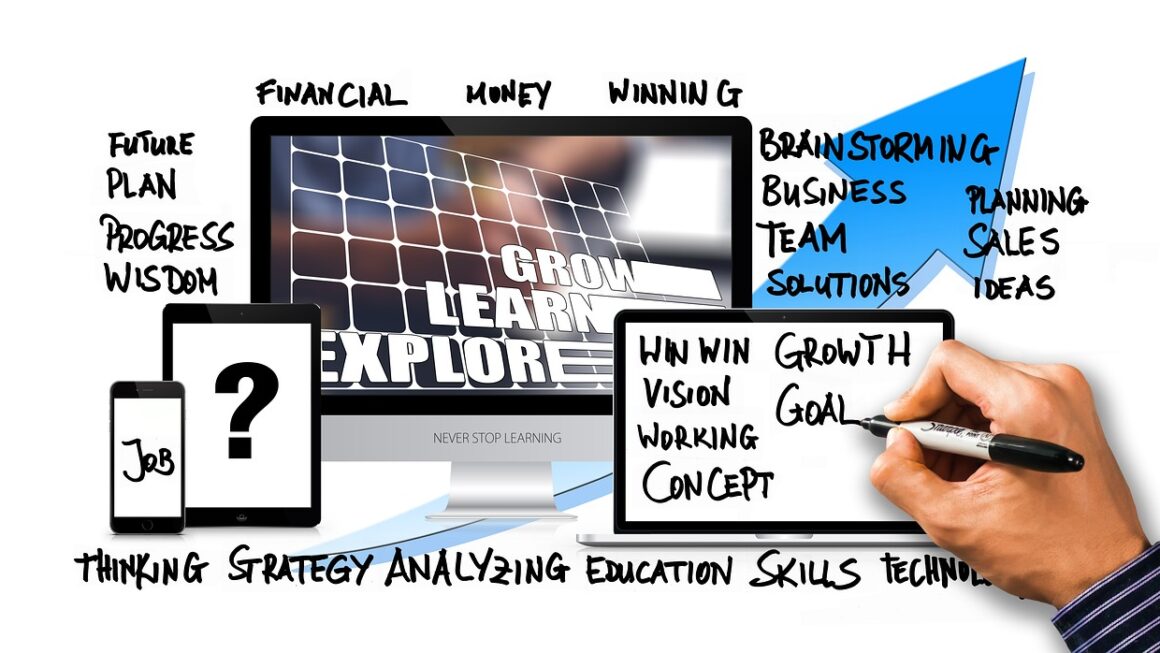The digital revolution has irrevocably transformed countless aspects of our lives, and education is no exception. From online courses and interactive learning platforms to virtual reality field trips, digital education is reshaping how knowledge is acquired, skills are developed, and futures are built. This blog post delves into the multifaceted world of digital education, exploring its benefits, challenges, and the innovative technologies driving its evolution. Whether you’re an educator, student, parent, or simply curious about the future of learning, join us as we unpack the power and potential of digital education.
The Rise of Digital Education: A New Paradigm
Defining Digital Education
Digital education encompasses the use of technology to enhance and support learning. It moves beyond traditional classroom settings, leveraging digital tools and resources to create more engaging, accessible, and personalized learning experiences. This includes:
- Online courses and degree programs
- Educational apps and software
- Interactive whiteboards and tablets
- Video conferencing and virtual classrooms
- Learning Management Systems (LMS)
The Driving Forces Behind the Digital Shift
Several factors are fueling the rapid growth of digital education:
- Accessibility: Digital education expands access to quality learning opportunities for students in remote areas or those with disabilities.
- Flexibility: Students can learn at their own pace and on their own schedule, accommodating diverse learning styles and personal commitments.
- Affordability: Online courses and programs can often be more cost-effective than traditional on-campus education.
- Technological advancements: Continuous innovation in hardware and software is creating increasingly immersive and interactive learning experiences.
- Global demand for skills: The digital economy requires a workforce equipped with specialized skills, which digital education is well-suited to provide.
- Pandemic impact: The COVID-19 pandemic accelerated the adoption of digital education, forcing institutions and individuals to embrace online learning solutions.
Benefits of Embracing Digital Learning
Increased Accessibility and Inclusivity
Digital education breaks down geographical barriers and provides learning opportunities for students who may not have access to traditional educational institutions. For instance, a student in a rural area can pursue a degree from a prestigious university through online programs. It also caters to students with disabilities, offering adaptive technologies and learning materials to meet their specific needs.
- Example: Closed captions and screen readers make online lectures accessible to students with hearing or visual impairments.
- Example: Students with learning disabilities can benefit from personalized learning paths and interactive exercises.
Enhanced Engagement and Interactivity
Digital learning environments offer opportunities for greater engagement and interactivity compared to traditional lectures. Gamification, simulations, and virtual reality experiences can make learning more fun and effective.
- Example: Educational games can teach complex concepts in an engaging and memorable way.
- Example: Virtual labs allow students to conduct experiments without the need for physical equipment.
Personalized Learning Experiences
Digital tools can track student progress and adapt learning materials to individual needs. This allows for personalized learning paths, ensuring that students receive the support and challenges they need to succeed.
- Example: Adaptive learning platforms adjust the difficulty of exercises based on student performance.
- Example: Personalized feedback and tutoring can help students overcome specific learning challenges.
Cost-Effectiveness and Efficiency
Digital education can be more cost-effective than traditional education, especially for online courses and programs. It also saves time and resources by eliminating the need for physical travel and infrastructure.
- Example: Online courses often have lower tuition fees than on-campus courses.
- Example: Students can access learning materials and complete assignments anytime, anywhere, saving time and travel costs.
Navigating the Challenges of Digital Education
Digital Divide and Access Issues
Unequal access to technology and reliable internet connectivity remains a significant challenge. This “digital divide” can exacerbate existing inequalities and limit access to digital education for students from low-income backgrounds or rural areas.
- Solution: Government initiatives and non-profit organizations can provide affordable internet access and devices to underserved communities.
- Solution: Offline learning resources and blended learning models can bridge the gap for students without consistent internet access.
Maintaining Engagement and Motivation
It can be challenging to maintain student engagement and motivation in online learning environments. Distractions, lack of face-to-face interaction, and technical difficulties can all contribute to decreased engagement.
- Solution: Incorporate interactive elements, such as quizzes, polls, and discussion forums, to keep students engaged.
- Solution: Provide regular feedback and support to help students stay motivated.
- Solution: Promote a sense of community through online group projects and social activities.
Ensuring Quality and Credibility
The proliferation of online courses and programs has raised concerns about quality and credibility. It’s important to ensure that online education meets the same standards as traditional education.
- Solution: Accreditation and quality assurance processes can help ensure that online programs meet recognized standards.
- Solution: Research and evaluate online courses and programs before enrolling.
- Solution: Look for reputable institutions and instructors with proven expertise.
Teacher Training and Professional Development
Effective digital education requires teachers to develop new skills and competencies. Training and professional development are essential to help teachers integrate technology effectively into their teaching practices.
- Solution: Provide teachers with ongoing training and support on using digital tools and resources.
- Solution: Encourage collaboration and sharing of best practices among teachers.
- Solution: Offer opportunities for teachers to experiment with new technologies and pedagogical approaches.
Innovative Technologies Shaping Digital Education
Artificial Intelligence (AI) in Learning
AI is transforming digital education by providing personalized learning experiences, automated feedback, and intelligent tutoring systems.
- Example: AI-powered platforms can analyze student performance and recommend personalized learning paths.
- Example: AI chatbots can answer student questions and provide instant feedback.
- Example: AI can automate grading and assessment, freeing up teachers’ time for other tasks.
Virtual and Augmented Reality (VR/AR)
VR and AR technologies are creating immersive and interactive learning experiences that can enhance engagement and understanding.
- Example: VR field trips allow students to explore historical sites or scientific environments without leaving the classroom.
- Example: AR apps can overlay digital information onto the real world, enhancing hands-on learning activities.
- Example: VR simulations can provide realistic training experiences for students in fields such as medicine or engineering.
Blockchain for Education Credentials
Blockchain technology can provide secure and verifiable digital credentials, making it easier for students to showcase their skills and accomplishments.
- Example: Digital diplomas and certificates can be stored on a blockchain, ensuring their authenticity and preventing fraud.
- Example: Blockchain-based portfolios can showcase student work and achievements in a secure and transparent way.
- Example: Employers can easily verify the credentials of job applicants using blockchain technology.
Learning Analytics and Data-Driven Insights
Learning analytics tools can collect and analyze data on student learning patterns, providing insights that can be used to improve teaching and learning.
- Example: Learning analytics can identify students who are struggling and provide targeted interventions.
- Example: Data on student engagement and performance can be used to improve course design and delivery.
- Example: Learning analytics can track the effectiveness of different teaching strategies and identify best practices.
Practical Tips for Effective Digital Learning
For Students:
- Create a dedicated learning space: Minimize distractions and create a comfortable and productive learning environment.
- Manage your time effectively: Set realistic goals, prioritize tasks, and schedule regular breaks.
- Engage actively in online discussions: Participate in forums, ask questions, and share your ideas with classmates.
- Seek help when needed: Don’t hesitate to contact your instructor or classmates if you’re struggling with the material.
- Utilize available resources: Take advantage of online libraries, tutoring services, and other support resources.
For Educators:
- Design engaging and interactive learning experiences: Incorporate multimedia elements, gamification, and collaborative activities.
- Provide regular feedback and support: Offer timely and constructive feedback to help students stay motivated and on track.
- Create a supportive online community: Encourage interaction and collaboration among students.
- Use technology effectively: Choose the right tools and resources to support your teaching goals.
- Continuously evaluate and improve your online courses: Gather feedback from students and use data to inform your teaching practices.
For Parents:
- Create a supportive home environment: Ensure a quiet, distraction-free space for learning.
- Monitor progress and offer encouragement: Check in regularly to see how your child is doing and offer support when needed.
- Communicate with teachers: Stay in touch with teachers to stay informed about your child’s progress and any challenges they may be facing.
- Help manage screen time: Encourage a balance between screen time and other activities.
- Promote digital safety: Teach your child about online safety and responsible digital citizenship.
Conclusion
Digital education is more than just a trend; it’s a fundamental shift in how we learn and teach. While challenges exist, the benefits of increased accessibility, enhanced engagement, and personalized learning experiences are undeniable. By embracing innovative technologies and addressing the digital divide, we can unlock the full potential of digital education and create a more equitable and effective learning landscape for all. The future of education is undoubtedly digital, and by understanding its potential and navigating its challenges, we can create a brighter future for learners worldwide.




